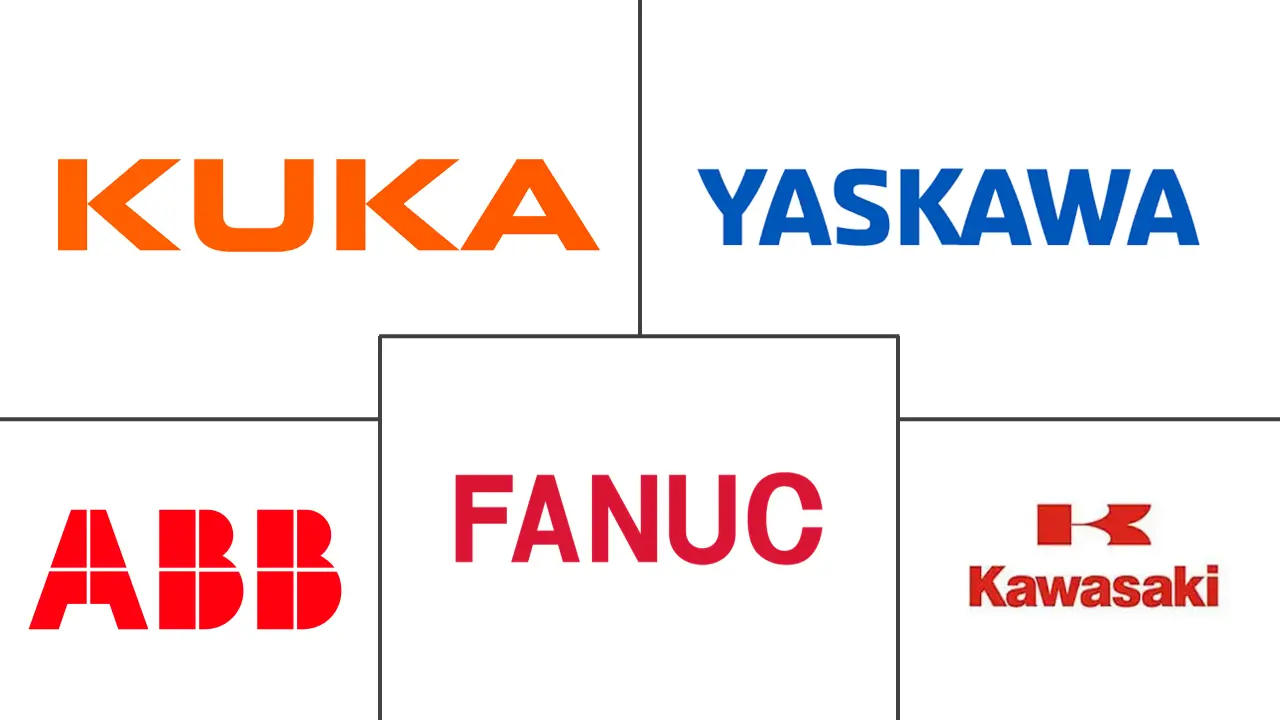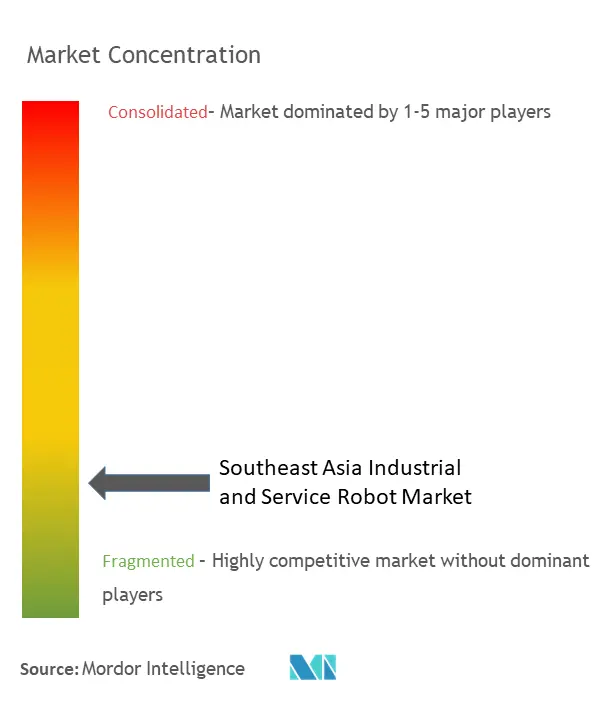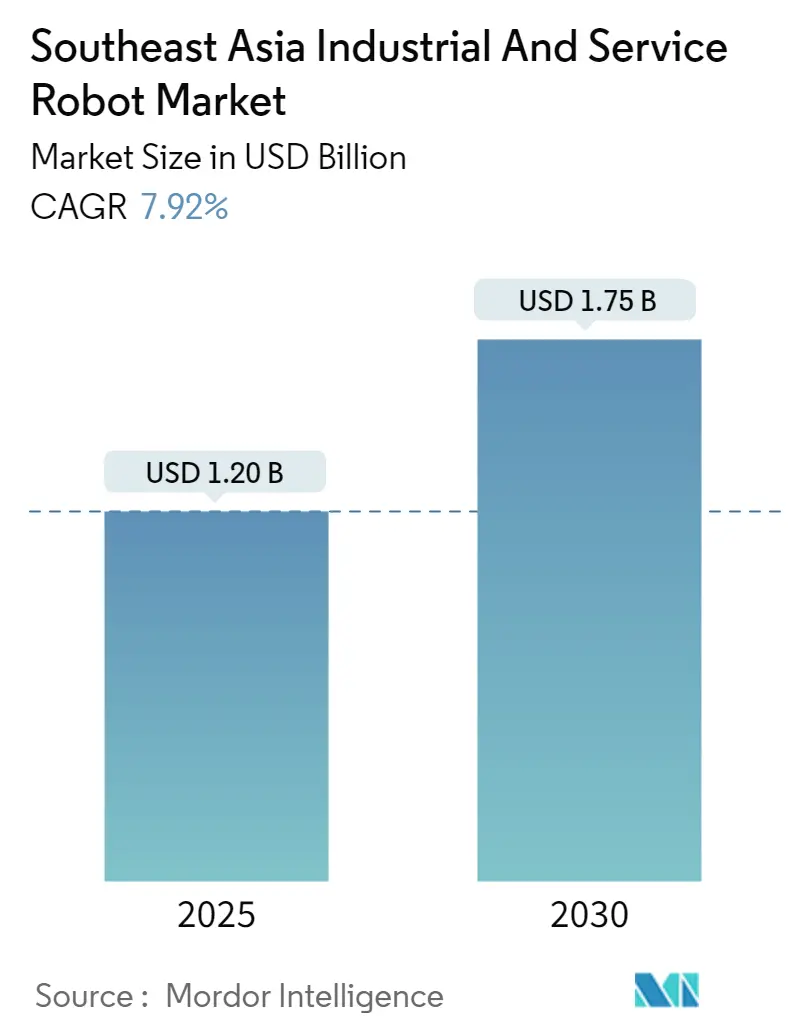
Southeast Asia Industrial And Service Robot Market Analysis
The Southeast Asia Industrial And Service Robot Market size is estimated at USD 1.20 billion in 2025, and is expected to reach USD 1.75 billion by 2030, at a CAGR of 7.92% during the forecast period (2025-2030).
The increasing developments in Southeast Asia regarding auto parts, electronics manufacturing, and logistics industries are leading to the growing demand for industrial and service robots.
- Southeast Asian countries are displaying remarkable progress in robot adoption. Numerous factors are probably contributing to the accelerated rates of robot adoption in the region. Several leading countries in the region have successfully set national goals and implemented distinctive strategies to encourage robotics innovation and promote the adoption of robots. Certain Southeast Asian nations have implemented proactive tax policies to incentivize adopting advanced robot technology.
- The increasing adoption of the Internet of Things (IoT) and investments in robotics in various Southeast Asian regions have played a significant role in driving market growth. The emergence of Industry 4.0, the latest industrial revolution, has also stimulated the advancement of innovative technologies, such as collaborative robots and AI-enabled robots. These advancements have empowered industries to enhance operational efficiency, reduce errors, and streamline numerous processes. The utilization of robotic systems has led to enhanced workplace safety and improved production capabilities, prompting further investments in this technology.
- The attractive lower operating costs in Southeast Asian countries have led global industrial robot companies to consider shifting their production capacity to the region. It is also enhancing productivity in sectors such as logistics, which involve various tasks that will greatly rely on the availability of more cost-effective robots. It is worth noting that robots are already making significant contributions to boosting productivity. They are involved in tasks such as waste collection, street cleaning, food preparation, and delivery and offering room service in hotels. The potential advantages and opportunities presented by industrial and service robots appear to be limitless.
- On the other hand, it is important to note that one of the major challenges for the market is the ever-changing needs and preferences of end users and their limited knowledge about upcoming technologies. The integration of technology also brings along cyber risks, which can make it susceptible to vulnerabilities.
- During the COVID-19 pandemic, there was an increased emphasis on digital transformation in various industries in Southeast Asian countries. This resulted in a greater utilization of robots in the region. Vietnam, for example, faced challenges but was projected by the Asian Development Bank (ADB) to be one of the fastest-growing economies in Southeast Asia. In response to the situation, the country employed robots and drones for tasks such as transporting medical supplies, infectious samples, essential goods, sterilization, and monitoring public areas.
Southeast Asia Industrial And Service Robot Market Trends
Electronics/Electrical to Witness Growth
- Industrial robots like articulated industrial robots and SCARA are heavily used in the electronics/electrical industry. Articulated robots are used for assembling electronic components and devices. They can handle delicate and precise tasks such as soldering and inserting components onto circuit boards. They are utilized in pick-and-place operations and are extremely useful in high-speed production lines where efficiency and precision are crucial. They can also perform visual inspections, check for defects, and ensure that products meet specific standards.
- Further, according to Statistics Malaysia, the manufacturing of electronic components and boards, communication equipment, and consumer electronics in Malaysia was estimated to contribute 4.9% to the gross domestic products in 2022, an increase from 4.6% in 2021. The manufacturing industry in Malaysia had a 23.4% share of the GDP in the same year, with electronic components manufacturing as the biggest contributor.
- Additionally, according to the Singapore Department of Statistics, in 2022, the industrial production index of computers, electronics, and optical products in Singapore was 129.24. This was the highest value in a decade. Singapore is among the leading manufacturers of electronics such as semiconductors worldwide, which is likely to amp up the growth in the market studied.
- In October 2022, armed with low prices and sophisticated technology, a prominent Indonesian contract manufacturer, Satnusa, announced that it is utilizing the global shift away from Chinese production to diversify its client base and become one of Southeast Asia's major players. Satnusa is wooing the US and European companies looking to shift production from mainland China and Taiwan to Southeast Asia. Many of the smartphones and other products it builds are currently sold in Indonesia.
- Satnusa benefits from government incentives as well. The entire island of Batam is designated a free trade zone, where companies enjoy cheaper import duties, streamlined export procedures, and other perks. Indonesia's government could provide additional benefits in a bid to boost exports. Such developments would offer several opportunities for the penetration of the market studied.
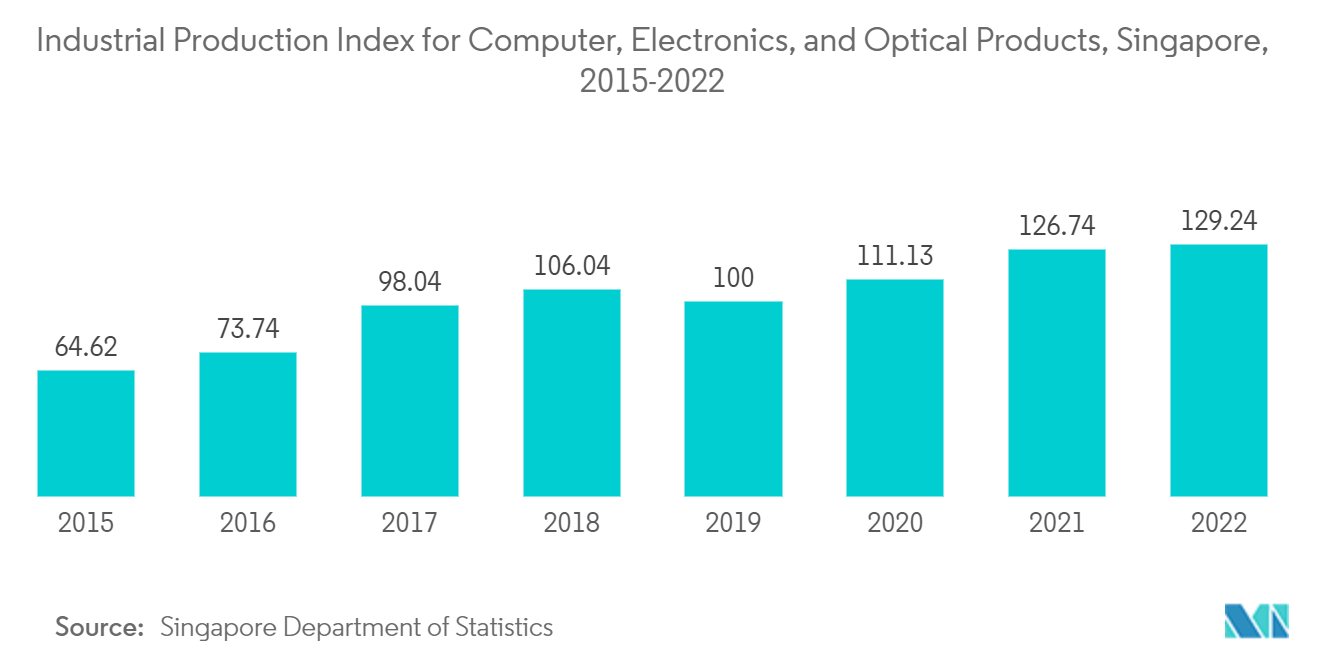
Indonesia is Expected to Hold a Significant Share
- Indonesia is a notable industrial manufacturer that extensively embraces automation in its sectors. Manufacturing plays a significant role in a nation's GDP, with Indonesia's manufacturing sector contributing more than 18% to the country's economic output in 2022, making it the primary contributor. The strong manufacturing activities in Indonesia and Malaysia are expected to bolster the demand for the market under examination.
- According to local economic studies, it has been determined that micro, small, and medium enterprises (MSMEs) constitute more than 99% of all business entities in Indonesia, with the food and beverage sector accounting for at least 44% of these enterprises. Consequently, the increasing adoption of technology in the manufacturing sectors of the region will significantly augment market prospects. As an illustration, the Indonesian government is actively encouraging the local food and beverage industry to embrace digital advancements and transition toward the utilization of technological innovations as an integral component of the national Making Industry 4.0 industrial strategy.
- As a result, the F&B sector is significantly witnessing innovative robotic adoption, and several vendors in the region are constantly investing in launching new solutions, which is creating a positive impact on the market's growth. For instance, in January 2022, GoFood made an announcement regarding its pioneering adoption of automated robot technology. The robot, affectionately named "Bellabot," is equipped with advanced features such as 3D sensors, sound detection, and touch-based interaction. This development reflects GoFood's unwavering commitment to enhancing the entire food ordering process and delivering an exceptional culinary experience to its users. By introducing this specialized robot, GoFood, as a part of the broader GoTo ecosystem, has become the first online food delivery (OFD) service in Indonesia to embrace automated robot technology. The implementation of automated robot technology by GoFood has been carried out in collaboration with PT Pudu Robot Indonesia. Such innovative vendor activities in enhancing technological adoption in the F&B sector will enhance the market's growth.
- Moreover, according to data provided by Statistics Indonesia (BPS), the food and beverage (F&B) industry experienced a 4.90% annual growth in 2022, reaching a value of IDR 813.062 billion (USD 51.82 billion). Additionally, the food and beverage manufacturing sector in Indonesia is projected to have a gross domestic product growth rate of approximately 4.9% in the same year. In addition, the country's GDP is expected to cross USD 2 trillion by 2028, according to the IMF. This notable expansion can be attributed to the increasing adoption of automation within the sector, which is expected to play a crucial role in driving market growth.
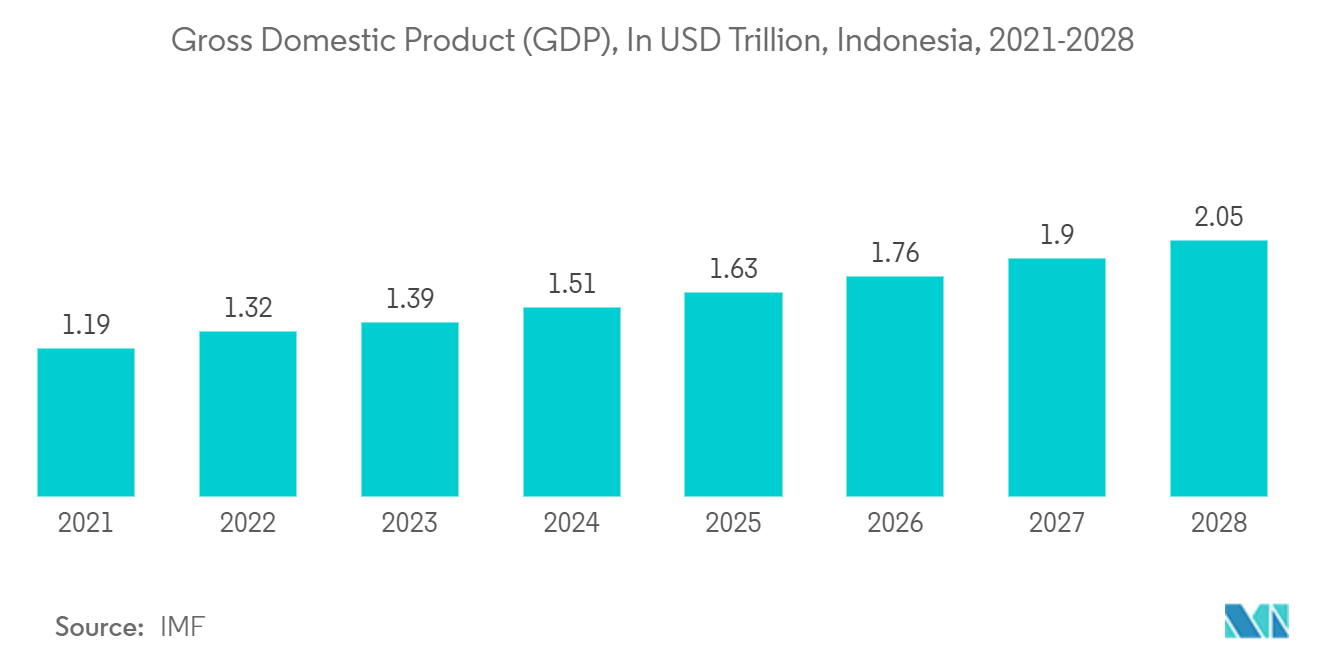
Southeast Asia Industrial And Service Robot Market Overview
The market comprises market incumbents, global firms, and new players competing to assert dominance in an increasingly contested market space. Industry 4.0 and digitalization initiatives across regions provide lucrative opportunities in the industrial robot market. New companies have emerged, differentiating themselves with respect to the robot controlling abilities. With technologies such as IoT, artificial intelligence, and virtual/augmented reality, such companies prosper with sizable revenue gains.
Numerous companies and emerging robot start-ups are dedicated to developing cutting-edge and technologically sophisticated solutions for manufacturers to enhance efficiency. Prominent industry players are actively pursuing acquisition strategies and creating innovative and integrated robots to cater to the needs of end users. Therefore, companies are aiming for a powerful competitive strategy. Some of the major market players are FANUC Corporation, Yaskawa Electric Corporation, KUKA AG, ABB Ltd, Kawasaki Heavy Industries Ltd, and many more.
- In August 2023, Yaskawa Electric Corporation announced the launch of a new lineup of MOTOMAN-HC30PL (30 kg payload capacity, 1600 mm reach), a model for palletizing applications such as cardboard, for the human collaboration robot series that has been developed with 10 kg and 20 kg payload capacity.
- In May 2023, KUKA expanded a new edition robot by launching the series of KR CYBERTECH for efficient automation. The KR CYBERTECH feeds components into assembly processes, checks workpiece quality, and grinds and polishes metal parts. This flexibility is particularly popular in various sectors, including dynamic industries such as metals and electronics.
Southeast Asia Industrial And Service Robot Market Leaders
-
FANUC Corporation
-
Yaskawa Electric Corporation
-
KUKA AG
-
ABB Ltd
-
Kawasaki Heavy Industries Ltd
- *Disclaimer: Major Players sorted in no particular order
Southeast Asia Industrial And Service Robot Market News
- July 2023 - KUKA expanded its range of autonomous mobile robots (AMR) with the KMR iisymobile cobot and KMP 1500P mobile platform. KUKA combines flexibility and reliability in demanding environments with the KMR iisy, a fully integrated combination of the cobot and transport platform, and the KMP 1500P, an innovative mobile platform. These robots are optimally equipped for production and storage facilities, providing the ideal competent partners for Industry 4.0.
- June 2023 - FANUC Corporation developed and started the sales of the ceiling-mounted SCARA robots SR-3iA/U (3-kg payload and 350-mm reach). The robot is optimal for transporting small parts between production lines and assembly work in small spaces.
Southeast Asia Industrial And Service Robot Market Industry Segmentation
Industrial robots are designed for industrial automation applications, while service robots are designed to perform useful tasks for people or equipment, excluding industrial automation applications.
The Southeast Asian industrial and service robot market is segmented by product category (industrial, articulated, and SCARA), service (professional and domestic), end-user vertical (automotive, electronics/electrical, plastic and chemical, metal and machinery, food, beverages, and tobacco), and country (Indonesia, Malaysia, Singapore, Thailand, Vietnam, and Rest of Southeast Asia). The market sizes and forecasts are provided in terms of value (USD) for all the above segments.
| By Product Category | Industrial | Articulated | |
| SCARA | |||
| Other Product Categories | |||
| Service | Professional | ||
| Domestic | |||
| By End-user Vertical | Automotive | ||
| Electronics/Electrical | |||
| Plastic and Chemical | |||
| Metal and Machinery | |||
| Food, Beverages, and Tobacco | |||
| Other Manufacturing Verticals | |||
| Other Non-manufacturing Verticals | |||
| By Country | Indonesia | ||
| Malaysia | |||
| Singapore | |||
| Thailand | |||
| Vietnam | |||
| Rest of Southeast Asia | |||
Southeast Asia Industrial And Service Robot Market Research FAQs
How big is the Southeast Asia Industrial and Service Robot Market?
The Southeast Asia Industrial and Service Robot Market size is expected to reach USD 1.20 billion in 2025 and grow at a CAGR of 7.92% to reach USD 1.75 billion by 2030.
What is the current Southeast Asia Industrial and Service Robot Market size?
In 2025, the Southeast Asia Industrial and Service Robot Market size is expected to reach USD 1.20 billion.
Who are the key players in Southeast Asia Industrial and Service Robot Market?
FANUC Corporation, Yaskawa Electric Corporation, KUKA AG, ABB Ltd and Kawasaki Heavy Industries Ltd are the major companies operating in the Southeast Asia Industrial and Service Robot Market.
What years does this Southeast Asia Industrial and Service Robot Market cover, and what was the market size in 2024?
In 2024, the Southeast Asia Industrial and Service Robot Market size was estimated at USD 1.10 billion. The report covers the Southeast Asia Industrial and Service Robot Market historical market size for years: 2019, 2020, 2021, 2022, 2023 and 2024. The report also forecasts the Southeast Asia Industrial and Service Robot Market size for years: 2025, 2026, 2027, 2028, 2029 and 2030.
Our Best Selling Reports
Southeast Asia Industrial And Service Robot Market Industry Report
Statistics for the 2025 Southeast Asia Industrial And Service Robot market share, size and revenue growth rate, created by Mordor Intelligence™ Industry Reports. Southeast Asia Industrial And Service Robot analysis includes a market forecast outlook for 2025 to 2030 and historical overview. Get a sample of this industry analysis as a free report PDF download.

